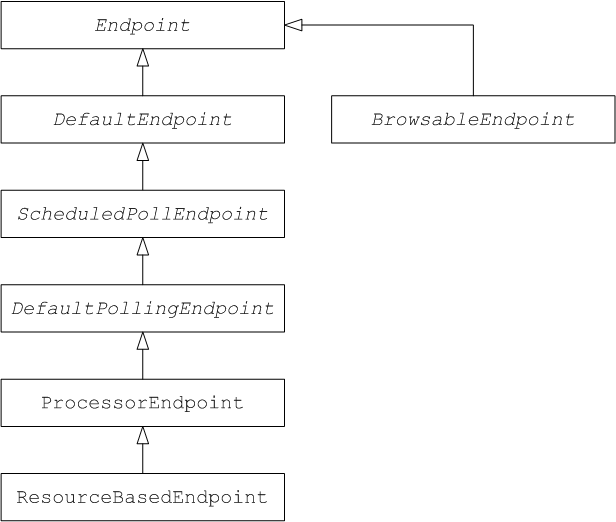第 40 章 端点接口
摘要
本章论述了如何实施 Endpoint 接口,这是实施 Apache Camel 组件中的基本步骤。
40.1. 端点接口
概述
org.apache.camel.Endpoint 类型的实例封装了端点 URI,它也充当 消费者、 和 Producer Exchange 对象的工厂。实施端点的方法有三种:
- Event-driven
- 计划轮询
- 轮询
这些端点实施模式与对应的模式补充,用于实施使用者","-abrtsee 第 41.2 节 “实现使用者接口”。
图 40.1 “端点继承层次结构” 显示构成 端点 继承层次结构的相关 Java 接口和类。
图 40.1. 端点继承层次结构
Endpoint 接口
例 40.1 “端点接口” 显示 org.apache.camel.Endpoint 接口的定义。
例 40.1. 端点接口
端点方法
Endpoint 接口定义了以下方法:
-
代表Singleton()InventoryService-abrtRe returnstrue,如果您要确保每个 URI 映射到 CamelContext 中的一个端点。当此属性为true时,指向路由中相同 URI 的多个引用始终引用 单个 端点实例。另一方面,当此属性为false时,对路由中同一 URI 的多个引用指的是 不同的 端点实例。每次引用路由中的 URI 时,都会创建一个新的端点实例。 -
getEndpointUri()abrt- the endpointRe 返回此端点的端点 URI。 -
在注册端点时,由
org.apache.camel.spi.LifecycleStrategy的getEndpointKey()Infoblox- InfobloxUsed by org.apache.camel.spi.LifecycleStrategy。 -
getCamelContext()进行对该端点所属的CamelContext实例的引用。 -
设置此端点所属的CamelContextSet。 -
配置Properties()>_<-jaxbStores 是参数映射的副本,用于在创建新Consumer实例时注入参数。 -
isLenientProperties()时间为true,表示允许 URI 包含未知参数(即,不能在 Endpoint 或Consumer类上注入的参数)。通常,应实施此方法来返回假。 使用以下变体
创建Exchange()3.10.0-- theAn overloaded 方法:-
Exchange createExchange()Infoblox-jaxbCreates a new exchange pattern 设置。 -
Exchange createExchange(ExchangePattern pattern)abrt-abrtCreates a new exchange instance with specified exchange pattern. -
Exchange createExchange(Exchange exchange)the givenexchange参数到此端点所需的交换类型。如果给定交换尚未正确类型,则此方法将其复制到正确类型的新实例中。DefaultEndpoint类中提供了此方法的默认实现。
-
-
createProducer()>_<->_<Factory 方法用于创建新的Producer 实例。 -
createConsumer()10.10.10.2-CustomizationFactory 方法,以创建新的事件驱动的消费者实例。processor参数是对路由中的第一个处理器的引用。 -
创建PollingConsumer()10.10.10.2->_<Factory 方法,以创建新的轮询消费者实例。
端点单例
为了避免不必要的开销,最好为具有相同 URI(通过 CamelContext)的所有端点创建一个端点实例。您可以通过实施 isSingleton() 来返回 true 来强制实施此条件。
在这个上下文中,同一 URI 意味着,使用字符串相等时两个 URI 相同。在原则上,可以有两个等效的 URI,虽然由不同的字符串表示。在这种情况下,URI 不会像一样对待。
